SEA WORM

Seaworm (Photo Credit : Nuyttens, Filip)
Sea worms belong to the phylum Annelida of the class Polychaeta. Annelida itself comes from the Latin anellus meaning small ring, it is a broad phylum made up of segmented worms, with about 15,000 modern species, including earthworms, pacets and leeches, among others. This phylum is found in most wet environments, such as freshwater and in the sea. The length of its members ranges from under one millimeter to three meters.
This phylum is grouped into three classes, namely Polychaeta, Oligochaeta, and Hirudinea. The class Polychaeta comes from the Latin language consisting of Poly and chetae, poly means many while chetae is a part that resembles hair located on the right and left edges of the worm's body. The distinctive feature of Polychaeta is the large number of chetae that look like legs all over its body. In some regions in Indonesia, sea worms are also called sea centipedes, this is because of the shape of the tuunhya that has legs that eat centipedes.
Sea worms (Polychaeta) are most dominant in macrozoobentos communities or ecosystems at the bottom of the water when viewed in terms of type and number. The distribution of sea worms is very wide, ranging from tidal areas to the deep sea. To date, more than 10,000 species have been described and are estimated to reach 25,000-30,000 types. Indonesia itself has a diversity of 525 species of seaworms collected in 189 genera and 44 tribes (Oceana, 2013). Some species even have a shorter lifespan, which is around 30-45 days. Sea worms can live in a variety of habitats such as muddy, sandy, and rocky bottoms. In general, they have a soft, slim, and cylindrical body. The colors are also attractive such as red, green, blue, brown and others due to the presence of pigments in the body. Sea worms that live on coral reefs often form limestone shells and play a biological role as coral decomposers.
Members of the phylum Annelida have been identified about 9,000 species and most of them consist of Polychaeta as many as 8,000 species. Because of the many species of Polychaeta, to distinguish them requires expertise between one species and another. According to Fauchaid, the main body parts of the seaworm that distinguish families and genera are the prostomium, peristomium, pharynx, parapodia, and setae. The general morphology of sea worms consists of a head, body, and tail.
Sea worms in some species are used for consumption, also used for fishing bait. The use of sea worms as natural feed for adult shrimp in shrimp hatchery centers such as in Cilacap, Serang, Situbondo and Barru Regency turns out to have different types. In general, people know sea worms by the local name of each region. Some people know all types of sea worms by the name Nereis worms. Although if you trace further the sea worms from some of these areas turn out to have different scientific names. The types that are used as natural feed for shrimp mothers include those from the Eunicidae and Nereidae families. The Eunicidae family consists of Marphysa sp.-1, Marphysa sp.-2, and Marphysa sanguinea. The Nereidae family consists of Nereis sp., Namalycastis sp., Perinereis nuntia.
Nereis sp. is more widely known to the local community and is used as a common name for all types of seaworms used in shrimp hatcheries, although after being identified the scientific name of the seaworm is not necessarily Nereis sp. This is natural because it is very difficult to distinguish the type visually, to distinguish it must be observed using a microscope and identification skills.
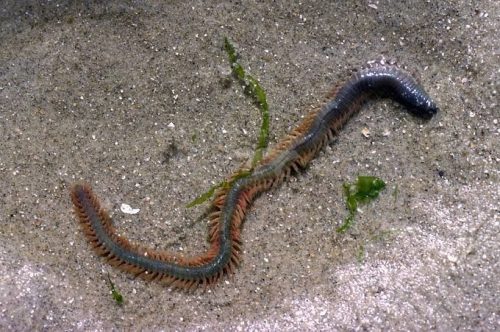
Nereis virens (Photo Credit : Dick Klees/Studio Wolverine)
The types of sea worms used as broodstock feed consist of 2 families and 6 types. All of these types have been used as one of the natural feeds for shrimp broodstock in shrimp hatcheries. Sea worms have the potential to be developed through cultivation. Sea worms still need various studies to reach their cultivation in Indonesia as they have been developed abroad. Seaworm cultivation can be used as an alternative research and business opportunity that is still wide open for the provision of natural feed in shrimp hatcheries.
Tomopteris helgolandica, which belongs to the family Tomopteridae, is a sea worm that is somewhat difficult to find because the habitat of this animal is located in the deepest sea zone (deep sea). As an adaptation of its habitat in the dark deep sea, sea worms have the ability to glow so that they become marine organisms that are quite contrasting and easy to see.
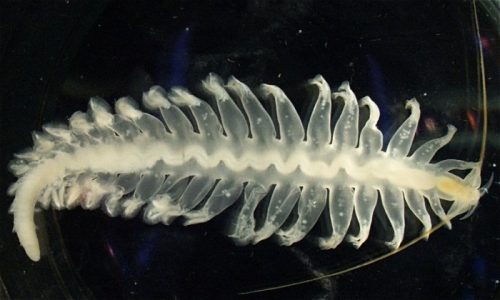
Tomopteris helgolandica (Photo Credit : Fisheries and Ocean Canada)
Classification of Sea Worms
Kingdom : Animalia
Phylum : Annelida
Class : Polychaeta
Order : Errantia
Morphology of the Seaworm (Nereis virens)
It has a lot of hair with a segmented body, each segment called an annulus. The head is in the anterior part, equipped with eyes, antennae, arostomium, jaw, pharynx, peristomium and palp. Its body clearly has capuz and appendages, divided into many segments. The first segment is called the peristonium and on each lateral part there are 2 pairs of tentacles. It belongs to the polychaeta class which means a lot of hair. On the anterior part there is a head equipped with eyes, tentacles and a jawed mouth. The body is attractively colored brownish-red.
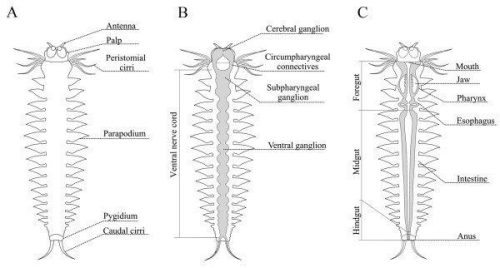
Anatomy of Nereis virens : (A) General view (B) Structures of central nervous system (C) Structures of digestive system (Photo Credit : Milana A Kulakova)
Visually, Nereis sp. has the following special characteristics. The dorsal prostomium consists of 2 antennae, 2 palps, 4 relatively large eyes, and 4 pairs of tentacular cirris which are divided into the lateral (left and right) parts of the worm's head.
Reproduction of Nereis
Generally, seaworms reproduce sexually. Have different sexes and intimate organs. Tier gonads (sex glands or reproductive glands) of seaworms produce sperm or eggs. Once the egg is ready, the gonadal ducts are formed but are removed by absorption after reproduction. They are in the larval stage, in the form of small prings and then blend with other floating marine plankton. Plankton are the basic contributors of nutrients to a large number of marine inhabitants. If the larvae manage to survive in the open sea, the miniworms develop in folds like inflated sacs. Once the worm is fully formed, the seaworm feeds its way out of the sac and falls to the seafloor, where it begins the eco-cycle again. Egg sacs can be eaten more than survive (natural selection).
The species Nereis virens is diesius, meaning that the male and female genitals are separated. Gonads develop only during the mating season. The gonads are found in all segments, except at the anterior end of the body. The ovaries and spermatozoa are found at the edges of the spleen.
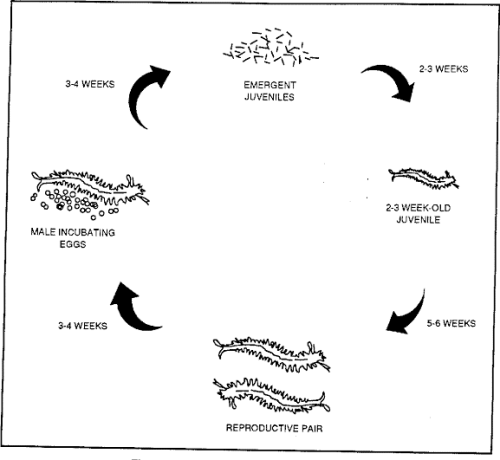
Reproduction of Nereis sp. (Photo Credit : T.Dillon, D.Moore, T.Bridges)
After the male and female cells reproduce, the cells will become larvae. The larvae will fly freely in the ocean or attach to coastal coral rocks. The larval food is in the form of plankton or other animal food residues. When entering the adult phase, the larvae will begin to grow segments starting from the back first. Then it will have feathers and legs and followed by the main part of the head. In the adult phase, these worms breathe using their special skin.
The Role of Seaworms in Ecosystems
The relationship between the seaworm and its habitat is that symbiotic can be in the form of parasites, mutually beneficial and also not mutually beneficial and not harmful. For example, in symbiotic mutualism (beneficial) coral reefs thrive from earthworm habits or activities such as feeding, reproduction, and excretion. Meanwhile, the sea worm supports itself on coral particulates. In contrast to Newquay's Blue Reef Aquarium, a 4-foot-long seaworm called the 'Giant Barry' is known to be a predator and damage many of the coral reefs in the aquarium.

Barry the giant sea worm (Photo Credit : Rex)
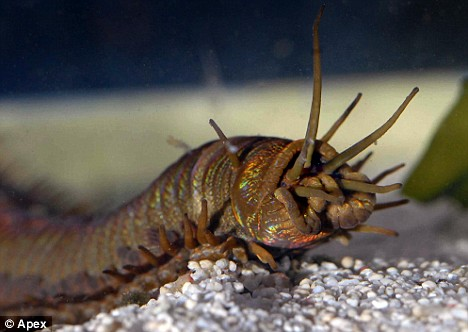
Barry the giant sea worm (Photo Credit : Apex)
In its symbiotic role as a parasite of sea worms it is even said to be a predator that successfully eats fish, snails, crustaceans and shellfish they can catch snails or bivalves by wrapping their bodies around their victims and injecting them with digestive enzymes. In symbiotic kemonsalism, Sea worms play a role in decomposing large dead animals. In addition, excretion activities by removing feces as nutrients as compost for microorganisms, bacteria and surrounding plants.
Not all sea worms live in the ocean, some species are in tidal pools or brackish water in the lowlands. Where the seaworm buries itself in the sediemen. And carry out water oxidation activities that are beneficial for plants and algae growth. The main ecological contribution of seaworms is as food for aquatic animals in the further food chain.
The potential of sea worms in the marine world is often used as a benchmark for underwater life, such as water pollutants, bacteria detection even at the level of the size of marine reserves, marine contaminants or the level of damage to the underwater system, for example, can be seen from the number of sea worms in the environment of the water area.
Seaworm Cultivation
In contrast to earthworm cultivation that has developed, seaworm cultivation in Indonesia is still at the research stage. Research on seaworm cultivation conducted by Edy Yuwono has been pioneered in Indonesia since the 2000s. The hatchery of lur worm type of sea worm (Dendronereis pinnaticirris) has been successfully carried out. Research from various aspects of cultivation for other types of sea worms, which are used in shrimp hatcheries in each region is still very much needed so that seaworm cultivation can develop in Indonesia as one of the efforts to provide natural feed for shrimp mothers.
In general, several types of sea worms have been successfully developed on an industrial scale in several countries, for example Nereis sp. has been successfully cultivated by the company Sea Bait Ltd. (UK) which has been developing it since 1985. In the UK, it has succeeded in developing large-scale cultivation of Nereis virens. Cultivation is carried out indoors and outdoors for intensive enlargement using a recirculation technology system and packaging has been carried out to be sent to consumers in various countries. If abroad sea worms can be developed, it is likely that they can also be cultivated in Indonesia.
Some species of sea worms in several regions in Indonesia that can be consumed include:
- The Bangka Seaworm (Metamastus mollus), known by its local name, is a type of seaworm that lives in the shallow waters around Bangka Island, Indonesia. This worm has a unique body shape, with a blackish-brown color and a body length of up to 20 cm. Bangka sea worms have an important role in the aquatic ecosystem, because they play a role in decomposing organic matter into nutrients. The tradition of hunting sea worms is called nyucuk wak wak, which is to hunt wak wak using a spear. These worms are processed to be used as snacks.
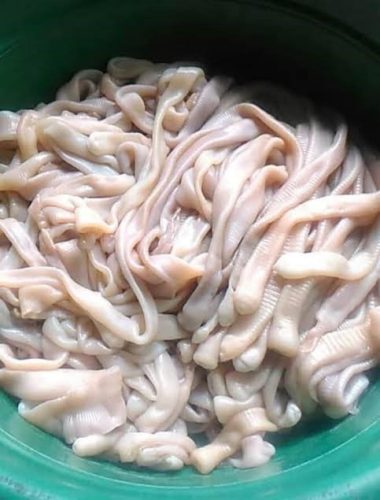
Bangka seaworms (Photo Credit : Google)
- Palolo Seaworm (Eunice fucata), included in the family Eunicidae. The cycle and behavior of palolo worms have a unique reproductive system, namely sexual and asexual. The behavior of polo worms will usually appear on the sea surface only 2-3 times a year, male polo worms are brownish-red while females are greenish-blue. Generally, conditions can be the reason and the right time for pololo worms to appear above sea level or pull over in shallow sea waters, in NTB Province Lombok island precisely on the south coast such as beaches (Kuta, Seger, etc.) appear in February – March. In Lombok there is an annual tradition of catching sea worms called "Bau Nyale", the word bau nyale refers to the activities of many people who catch sea worms.
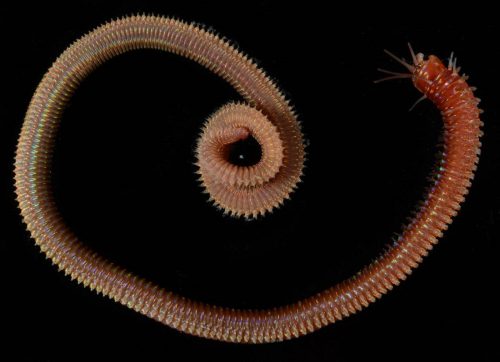
Eunice fucata (Photo Credit : Lasley, Robert/University of Florida Invertebrate Zoology Collection)
- Laor/Wawo Seaworm (Eunice viridis), the local people call the sea worm as Laor. Laor is one of the typical biota in the waters of Mai Ambon Island or also known by the name of the Wawo worm. This soft animal appears on the surface of the water once a year, namely in March or April on a full night or a few days after. The factors that support the presence of Laor are driven by the tides of seawater and high salt levels. This condition is used by worms to reproduce, because there is a seasonal transition from hot (west) to rainy season (east). From research conducted by Pattimura University, it is stated that this marine life emerged to do swarming, which is an event when seaworms of certain types swarm in abundant numbers around the water surface to mate externally. This animal is usually caught by locals on coral beaches using traditional seser and used as a traditional food. So far, the people of Latuhalat Village, Allang Village, and Hutumuri Village on Ambon Island have used Laor as a traditional food ingredient because it is believed to contain a lot of protein. Generally, these worms are processed by the community by frying, pepes, and salting.
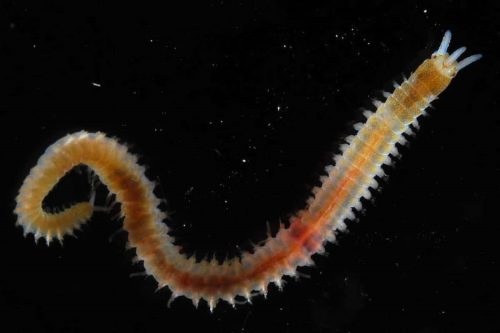
Eunice viridis (Photo Credit : BioPills)
-YN
References
Megumi, Sarah: Mengenal Cacing Laut atau Laor dari Maluku https://www.greeners.co/flora-fauna/mengenal-cacing-laut-atau-laor-dari-maluku/
https://www.kompasiana.com/elizabethadelinee/61c9603806310e4a200a61f2/mengenal-biota-laut-cacing-laut-tomopteris-helgolandica?
https://id.wikipedia.org/wiki/Cacing_laut
http://www.dailymail.co.uk/sciencetech/article-1165930/Barry-giant-sea-worm-discovered-aquarium-staff-mysterious-attacks-coral-reef.html
Purnomo, Gery Worm Palolo, Wawo, or Laor; Classification, Morphology, Habitat Etc https://www.melekperikanan.com/2020/01/klasifikasi-kingdom-animalia-phylum.html

